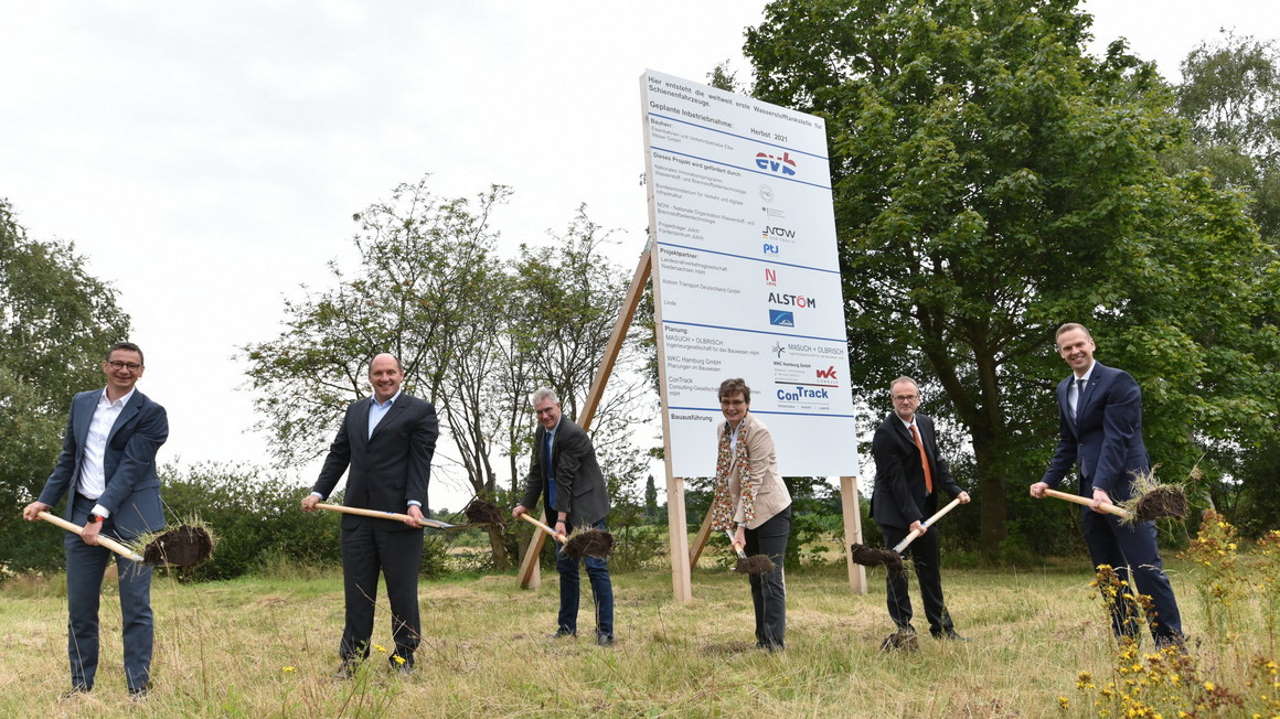In Lower Saxony’s Bremervoerde, Germany, the world’s first hydrogen filling station for passenger trains will start being built in September.
Representatives met on-site for a ground-breaking ceremony after an eighteen-month testing phase for the first two trains, which was completed in February.
The gases and engineering company, Linde, will build and operate the hydrogen filling station near Bremervoerde station on behalf of the Lower Saxony Regional Transport Company (LNVG).
After completion expected in mid-2021, the hydrogen filling station will replace the existing mobile filling solution.
From the beginning of 2022, 14 hydrogen-powered regional trains built by Alstom will be refuelled there daily and around the clock if necessary.
“The ground-breaking ceremony for this world’s first hydrogen filling station for passenger trains is an important step for a showcase project from Lower Saxony”, said Carmen Schwabl, Managing Director of LNVG. The initiative to test the gas as a fuel in local rail passenger transport came from LNVG.
“We are delighted to play a key role in this world-leading, innovative project,” said Mathias Kranz, responsible at Linde for the on-site and bulk business in Germany. “Linde has long been committed to hydrogen, which can make a significant contribution to decarbonisation. The introduction of hydrogen as a fuel for trains will significantly reduce the burden on the environment, as one kilogram of hydrogen replaces approximately 4.5 litres of diesel fuel”.
“The construction of the hydrogen filling station in Bremervörde will create the basis for the series operation of our emission-free hydrogen trains in the Weser-Elbe network. We really appreciate that Linde, as an experienced hydrogen supplier, is now also taking over the refuelling of the series trains following the successful trial operation,” comments Jörg Nikutta, Managing Director Germany and Austria of Alstom.
“We are proud that we were the first railway company in the world with permission to operate fuel cell trains on the Weser-Elbe network. Our passengers were very curious about the trains and their technology from the very beginning. In addition to the very low noise level, the hydrogen train impresses with its zero emissions, especially in times of climate change. For our train drivers, the operation of iLint was a very special motivation”, said Andreas Wagner, head of the SPNV division and authorised signatory of the Eisenbahnen und Verkehrsbetriebe Elbe-Weser GmbH.
Where Next?
RailAdvent Plus
Get image downloads, Prints and Streaming Video
News Homepage
For the Latest Railway News
RailAdvent Online Shop
Railway Prints, DVD’s / Blu-Ray’s and more
LocoStop – The RailAdvent Community
Come and share your railway pictures
Mainline UK Steam Info
Upcoming mainline steam tours/loco movements
Alstom
Visit their website






Responses
How is the hydrogen being produced? If it is from steam-reforming of methane (as it usually is) the byproduct is greenhouse gas carbon dioxide which almost certainly goes into the atmosphere. Same argument applies if made by electrolysis using electricity made in fossil-fuel powered generating stations. Only if the hydrogen is made using electricity from renewables (or nuclear) is this truly zero-carbon and zero-emission. These stories about hydrogen should be telling us this. (See also Ian Watkins’s comment.)
Funny, isn’t it, that such information is always conveniently overlooked by those trumpeting the virtues of the latest magical “green” energy source.
Even electricity from renewables and nuclear has significant adverse environmental impacts – consider the energy required to produce the huge amounts of concrete and steel used in construction of plant, the diesel-powered generators on standby to cover shortfalls in solar and wind power, the rare minerals mined in China under abysmal environmental conditions to produce magnets for motors and generators, the disposal and ongoing protection of nuclear waste etc etc – the list goes on.
As a means of transferring energy from source to train wheel, hydrogen is less efficient than battery power and far less efficient than full electrification, even ignoring the hazards and practical difficulties of storing, transporting and containing the stuff.
Lignite is one of the dirtiest, most polluting fuels available. Germany burns a lot of it to produce electricity so there is a good chance that some if not all of the power used to produce this hydrogen comes from that source.
Is it any wonder that people are so cynical about so-called “green energy”?
Just to note: Emission-free at the point of use.
If they are burning lignite to generate the electricity to create the Hydrogen then they are not emission-free in any real sense of the word.